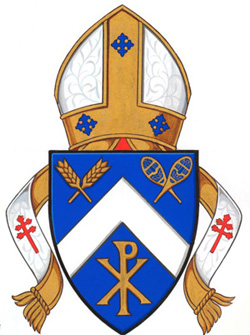
(In Blazon, the language of heraldry)
Azure a chevron Argent between in chief, two ears of wheat in saltire, and two snowshoes in saltire, and in base a Chi-Rho Or.
Heraldry originated about a thousand years ago in Europe, where it was used by the warrior classes as a means of differentiating combatants on the field of battle. As Europe developed and the feudal warrior class disappeared, the practice of identifying one’s possessions with personal emblems flourished.
Ecclesiastical heraldry grew out of this practice, initially to differentiate between the various degrees of the clerical estate.
The Symbolism
For our new coat of arms, we turned to the Canadian Heraldic Authority, which is commissioned to carry out this work by the Governor General.
The mitre used was created especially for Canadian Catholic dioceses.
On the gold orpheys are three blue crosses with lily-like terminations; the number three indicates the Holy Trinity and the lily is a symbol of St. Joseph, patron of the Church in Canada.
On the lappets (white with gold lining) are red crosses with maple leaf terminations, representative of Canada. The crosses have a double transverse, indicating the metropolitan cross of an archdiocese.
On the shield, the colour blue refers to the healing waters of Lac Ste. Anne, the site of the first Catholic mission in the area, to the waters of Baptism, and to Mary, the mother of Christ.
White refers to the truth and hope Christians find in the Gospel, while gold refers to the providence and glory of God.
The chevron represents a carpenter’s square, another emblem of St. Joseph, the patron of the Archdiocese. It also alludes to the Rocky Mountains in the west of the Archdiocese.
The ears of wheat are a Eucharistic symbol of the Bread of Life; they also refer to prairie agriculture.
The snowshoes represent the ministry of the first bishop, Vital Grandin, who was said to have walked 25,000 miles in snowshoes during his ministry.
The Chi-Rho, which combines the Greek letters X and P (Ch and R in the Roman alphabet), refers to the name of Christ.
